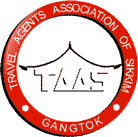|
Places of Interest East Sikkim Govt.Handicraft Centre: This centre houses authentic sikkimese art and handicraft. Witness the local artisans at work here. It is a good place to purchase souvenirs to take back home. Namgyal Institute of Tibetology: This institute has on display an impressive repository of rare Buddhist books, icons, thankas and gold calligraphy. Do-Drul Chorten: Close to Tibetology, built in 1945-46 by Trullshi Rimpoche, one of the biggest stupas found in sikkim.The imposing Chorten is surrounded by 108 prayer wheels.
Himalayan Zoological Park: About 8 km away from Gangtok town is where one can see Red Panda, Barking Deer, Himalayan Black Bear, Tibetan Wolf among other animal in semi-natural habitat. Rumtek Dharma Chakra Centre: Is at about 45 minutes drive from Gangtok town. It is the seat of Kagyud order of Tibetan Buddhist sects. The Centre has some of the worlds most unique and rare religious scriptures and objects. It is close replication of the Kagyu head quarters in Tibet. The Karmapa lineage is the ultimate head of this sect.
Jig Back Ropeway: Inaugurated on 7th December 2003, the rope way operates between Main Secretariat Deer Park, Sikkim Legislative Assembly and the Tibetology at Deorali.The two cable cars have a capacity of accommodating 25 passengers at one time. The ride gives a breathtaking view of the river about 1000 meters below as well as the Deorali Bazaar. Hure Hure Dara: Located just next to the Sikkim Legislative Assembly and the ropeway terminus, this view-point offers an excellent view of the deep valley below with the river Ro-ro chu snaking through it. Nehru Botanical Garden: This garden is located just half a kilometer before the Rumtek Monastery on the highway. A mixture of well tended tropical and temperate plants and trees can be found here. A cemented footpath winds its way through the garden and is good for taking a relaxed stroll. The sprawling town of Gangtok can be seen on the hill opposite. The garden is indeed an ideal picnic spot. Tashi View Point: Situated about six kilometers away from Gangtok town on the North Sikkim Highway, this place offers astounding view of Mt.Kanchandzonga snowy range.. Ganesh Tok: Is a view point from where a panoramic view of Gangtok town and Raj Bhavan Complex can be seen. A small temple of Lord Ganesh is built here.
Tsomgo Lake Tour: At an altitude of 12,400 feet (35 km) is about 2 hrs drive uphill. The ethereal atmosphere around the tranquil lake, surrounded by the hills is overwhelming. A footpath along the lake takes one to a resting shed, a walk of about half a kilometer. During the winter months the lake becomes frozen. One can also enjoy yak and mule ride around the lake.
Baba Mandir: The temple lies on the road between the Nathula and the
Jelepla pass. This temple
Nathula Pass: at one of the highest motorable roads in the world is situated at an altitude of about 14,200 ft.It is the border between India and China. West Sikkim PELLING: Situated at an altitude of 6,800 ft is the viewpoint for the snow capped Kanchendzonga range and provides easy access to other interesting locations in the districts. Pelling somehow seems to have developed into a hub of tourism activities in West Sikkim. Khecheopalri: Situated at an altitude of about 1951 m (6400 ft). This lake defines peace and tranquility.Khecheopalri means the Wishing Lake. The water in this lake is placid and crystal clear. Not even a leaf can be seen floating on the water surface although there is a beautiful dense forest above the lake. It is said that if a leaf drops on the surface of the water it is picked by a bird. It is one and half hours drive away from Pelling. Kanchendzonga Waterfalls: is about an hour’s drive from Pelling. The vigorous descent of sparkling water will enthrall you. The thunder of the icy cold water cascading down the granite rocks resounds in the surrounding.
Tashiding Monastery: This monastery was built in 1717 by Ngadak Sempa Chembo during the reign of the third Chogyal Chakdor Namgyal. It was constructed on the top of a heart shaped hill with the backdrop of Mt. Kanchendzonga. It is also famous for holy stupas known locally as chorten. The Bumchu Ceremony, opening of the sacred pot containing holy water, is held every year on the 15th day of the first lunar month. The pot is believed to have been blessed by Lhatsun Chenpo, a Buddhist saint of the 17th century. This ceremony signifies sikkim`s future for the year ahead. Fambrong Waterfalls: Though not as majestic as the Kanchendzonga waterefalls, Fambrong does offer a spectacular sight. These waterfalls are located about 10 kms away from Tashiding towards Yuksom. Dubdi Monastery: Dubdi means ` The Retreat` (built in 1700) located near Yuksom on a hill top. Singshor Bridge: This suspension bridge is located about 25 kms from Pelling and about 5 km ahead of Dentam towards Uttarey.The bridge has been built over a gorge that is about a thousand feet deep. Shri Kiriteshwar Temple (Legship) : Situated 16 kms from Gyalshing on the Gangtok-Gyalshing highway on the banks of the River Rangit, this Hindu temple is dedicated to God Shiva. The temple is fast developing into a favorite stop over point for tourists going to Pelling and Yuksom.
Rabdanste Palace Ruins: was the second capital of Sikkim and was established in the late seventeenth century by the second Chogyal of Sikkim. The Rabdanste Palace is in ruins and one has to trek about 2 kms from the main road near Pemayangtse Monastery through a thick forests to reach it. The chortens around the palace have however withstood the elements of nature. The ruins are now being preserved by the Archaeological Survey of India and have been declared as a monument. Sanga Cheoling Monastery: Sanga Cheoling means `The Island of esoteric Teaching`. This oldest monastery of Sikkim was built in 1697, seven kilometers from Pemayangtse. South Sikkim Guru Padmasambhava: (The 2nd Buddha) also known as Guru Rimpoche visited and blessed Sikkim in eighth century thus giving birth to Buddhism in Sikkim. The 138 ft statue at Samdruptse,(Namchi) is the tallest statue of Guru Padmasambhava in the world. The statue was unveiled on 18th February 2004. The grandeur of the holy sight is sure to awestruck the visitors in near future.
Namchi : (4300 ft) and 78 kms from Gangtok is the district headquarters of South Sikkim.On a clear morning, Darjeeling Kalimpong and the distant valleys are visible from here. Tendong Hill: at an altitude of 2640 m (8660 ft) is situated on a small plateau on top of the mountain. From here the view is just spectacular. It is like sitting in the centre of a huge amphitheatre. Both the sunrise and the sunset are breathtaking from Tendong. It gets its name meaning “The upraised horn” from the Lepcha lore that when their land was submerged in water. Meanam Hill: (10,300 ft) the hill towers over South Sikkim with Tendong on one side and Ravangla Bazaar on the other. On a clear day, it is even possible to see the plains of West Bengal and a Himalayan span of the Indo-China border towards the North. A short distance away is the legendary Bhaley Dunga, a rocky spur that juts out from the ridge top and remains suspended in the air above Yangang Village. The trek to Meanam from Ravangla takes about 4 hours and from Meanam hilltop one has the option to take the gentle walk down to Borong village or the more treacherous trails taken by the famous British Botanist, Sir Joseph Hooker, down to Yangang village North Sikkim
Phodong Monastery: This monastery belongs to the Kargyupa Sect (Karmapa) is situated about a kilometer uphill by a jeepable road that bifurcates from the North Sikkim Highway. It was built by the Chogyal Gyurmed namgyal somewhere in the first quarter of the eighteenth century. The main annual puja is performed on the 28th and 29th day of the tenth month of the Tibetan calendar two days before Losoong when the religious Chaams or dances are also demonstrated. Singhik : is another viewpoint for Mt. Kanchendzonga, Mt.Pandim, Mt. Kabru, Mt. Simvo, Mt. Jano and Mt. Siniolchu on a clear day. Chungthang: At an altitude of about 1585 m (5200 ft) Chungthang lies at the confluence of Lachen Chu (Teesta) and Lachung Chu. It is a quite small village surrounded by the mountains. From here also the road bifurcates for the Lachen and Lachung Village.
Yumthang: Yumthang at an elevation of 11800ft and 140kms drive from Gangtok is a paradise for nature lovers with fascinating blend of flora and fauna and breathtaking scenic grandeur. The valley is also the home of Singba Rhododendron Sanctuary with 24 species of Rhododendrons. The valley is frozen in the winter and comes alive with multicolor carpet of Rhododendrons,Primula,Primros and many otherwildflowers.Yumthang `Tsa-Chu` or the Hot Spring of the left bank of Lachung River is immensely popular for its curative properties and healing power. Hot water rich in sulphur, ananates from a spring just behind the hut and is diverted into the pools. It is difficult to imagine that water so hot in its natural form could be found in a place so cold. It is so remote and almost untouched by the vagaries of civilization, yumthang is that unique place where the tree line ends, but rhododendron still bloom covering the whole area in surreal shade Katao Snow Point: At an altitude of 13500ft.It is an hour drive from Lachung.People believe that one will find snow here almost throughout the year. You require permission from the army to visit this place.
Lachen: Lachung’s sister village Lachen is only a recent host to tourists. Situated at an altitude of 9000ft and about 6hrs drive from Gangtok.It stands on a grassy and bush flat from the periphery of which rise the pine clad mountains with their snowy peaks and black cliffs. The village comprises of barely 150houses, earlier inhabited only in winter by their owners who spend the summer on the alpine pastures along the Tibet border tending to their flock of yaks. Lachen is the base for exploration of Gurudongmar Lake and Chopta Valley. It’s also the preparation point to Green Lake Trek and Kanchendzonga Expedition. Thangu: Thangu is at an altitude of 13000ft (plus) and 3 hrs drive from Lachen.A small village where the visitors usually acclimatize before they proceed to Gurudongmar Lake or some Treks. Chopta Valley: situated at an altitude of about 13,200 ft is just a 20 minutes drive from Thangu Village where one can walk over frozen rivers in the winter. Gurudongmar Lake: Gurudongmar Lake is considered as one of the sacred lakes of this State both by the Buddhist and the Hindus. It is situated at an altitude of 17200ft.The blessed water of this lake is believed to possess the miraculous power of granting children to childless couples. The lake remains milky in colour throughout and it is believed that Guru Padmasambhava had touched the lake whilst he visited Tibet from this area. The lake freezes over during winters except at one spot, which the devotees believe has been specially blessed. No visit to North Sikkim is complete without a visit to this holy lake. |
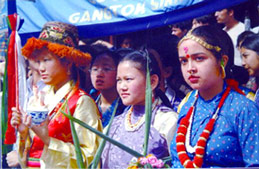
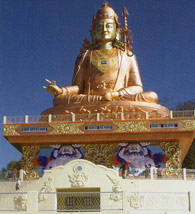 Enchey
Monastery: built in 1910 and revered by the local people follows the
Nyingmapa order of Tibetan Buddhism. The monastery was built over a site
believed to be the hermitage site of Lama Drupthob Karpo.
Enchey
Monastery: built in 1910 and revered by the local people follows the
Nyingmapa order of Tibetan Buddhism. The monastery was built over a site
believed to be the hermitage site of Lama Drupthob Karpo.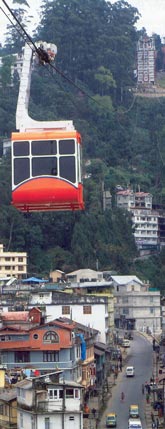 Flower
Show: displays varieties of endemic and exotic orchid hybrids.
Flower
Show: displays varieties of endemic and exotic orchid hybrids.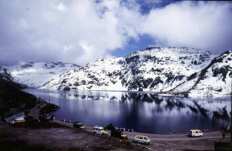 Hanuman
Tok: Situated about five kilometers uphill from White Hall on a
bifurcation road of the Gangtok Nathula Highway, is a temple of God
Hanuman at an altitude of 2195m (7200ft).From the temple the snowy peak
of Mt. Kanchendzonga presents a panoramic picture. The temple of Hanuman
is flanked by a small temple of Shirdi Saibaba..
Hanuman
Tok: Situated about five kilometers uphill from White Hall on a
bifurcation road of the Gangtok Nathula Highway, is a temple of God
Hanuman at an altitude of 2195m (7200ft).From the temple the snowy peak
of Mt. Kanchendzonga presents a panoramic picture. The temple of Hanuman
is flanked by a small temple of Shirdi Saibaba..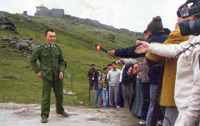 has
acquired the status of a place of pilgrimage over the years. This temple
was built as a monument in the memory of one sepoy Harbhajan Singh from
the Punjab Regiment who fell into a stream and drowned while escorting a
column of mules carrying provisions. This temple is visited by thousands
of tourists as well as the locals.
has
acquired the status of a place of pilgrimage over the years. This temple
was built as a monument in the memory of one sepoy Harbhajan Singh from
the Punjab Regiment who fell into a stream and drowned while escorting a
column of mules carrying provisions. This temple is visited by thousands
of tourists as well as the locals.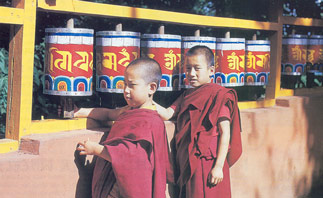 Pemayangtse
Monastery: This monastery is situated at an altitude of about 2105 m
(6840 ft) about 6 kms from Gyalshing town and less than a kilometer from
pelling.It is one of the oldest monasteries in sikkim.This ancient
monastery belongs to the Nyingma sect of Buddhism. It is one of the
premier monasteries, having been entrusted with the task of performing
all religious functions of the erstwhile monarch.
Pemayangtse
Monastery: This monastery is situated at an altitude of about 2105 m
(6840 ft) about 6 kms from Gyalshing town and less than a kilometer from
pelling.It is one of the oldest monasteries in sikkim.This ancient
monastery belongs to the Nyingma sect of Buddhism. It is one of the
premier monasteries, having been entrusted with the task of performing
all religious functions of the erstwhile monarch.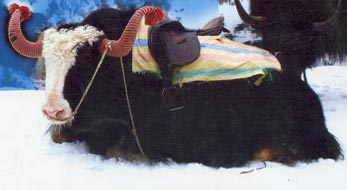 Phurchachu
Reshi Hot Spring: This hot spring is located about 25 kms from
Gyalshing near river Reshi on the River Rangit.The water of this spring
has medicinal value as it contains sulphur and can cure some skin
diseases. This spring is also considered very holy as the holy cave
called the Kadosang Phu is located here.
Phurchachu
Reshi Hot Spring: This hot spring is located about 25 kms from
Gyalshing near river Reshi on the River Rangit.The water of this spring
has medicinal value as it contains sulphur and can cure some skin
diseases. This spring is also considered very holy as the holy cave
called the Kadosang Phu is located here.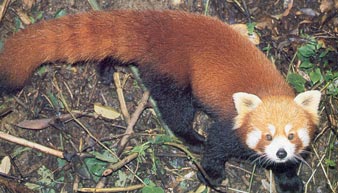 Ravangla:
(8000 ft) is the small picturesque semi town on the Gangtok- Gyalshing
highway.Ravangla is among one of the few places in Sikkim to offer an
undisturbed view of the snow ranges of Greater Himalayas. Mt.
Kanchendzonga, Mt. Pandim, Mt. Siniolchu, Mt. Kabru are just the few of
the major peaks that are clearly visible from here.
Ravangla:
(8000 ft) is the small picturesque semi town on the Gangtok- Gyalshing
highway.Ravangla is among one of the few places in Sikkim to offer an
undisturbed view of the snow ranges of Greater Himalayas. Mt.
Kanchendzonga, Mt. Pandim, Mt. Siniolchu, Mt. Kabru are just the few of
the major peaks that are clearly visible from here. Kabi
Lungtsok : 24 kms from Gangtok, where the treaty of brotherhood was
signed between the Lepcha chieftain Thekong Tek and the Bhutia chief
Khye Bumsa in the 13th
century.Stone markers were erected to keep the promise alive.
Kabi
Lungtsok : 24 kms from Gangtok, where the treaty of brotherhood was
signed between the Lepcha chieftain Thekong Tek and the Bhutia chief
Khye Bumsa in the 13th
century.Stone markers were erected to keep the promise alive. Lachung:
Situated at an altitude of 8600ft Lachung is a bhutia village with a
unique local self-governing body called Zumsa which substitutes the
Panchayat. Lachung has been described as “the most picturesque village
of Sikkim” by Joseph Dalton Hooker in his definite, the journal (1855).
Lachung has emerged a tourist destination with the base for an
exploration of Yumthang, which is just 24 kms away.
Lachung:
Situated at an altitude of 8600ft Lachung is a bhutia village with a
unique local self-governing body called Zumsa which substitutes the
Panchayat. Lachung has been described as “the most picturesque village
of Sikkim” by Joseph Dalton Hooker in his definite, the journal (1855).
Lachung has emerged a tourist destination with the base for an
exploration of Yumthang, which is just 24 kms away.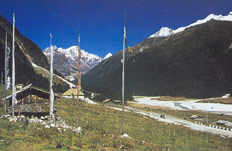 Yumesamdong:
Another 23kms drive beyond Yumthang takes one to Yumesamdong
(15300ft).Hot spring of Yumesamdong on the river Sebu-chu at the foot of
the mountain on which lies Donkiala Pass that connects the lachung
valley to lachen valley. The area of Yumesamdong where the sweet
fragrance of Azellia (a plant used as incense by the locals) permeates
the air.
Yumesamdong:
Another 23kms drive beyond Yumthang takes one to Yumesamdong
(15300ft).Hot spring of Yumesamdong on the river Sebu-chu at the foot of
the mountain on which lies Donkiala Pass that connects the lachung
valley to lachen valley. The area of Yumesamdong where the sweet
fragrance of Azellia (a plant used as incense by the locals) permeates
the air.